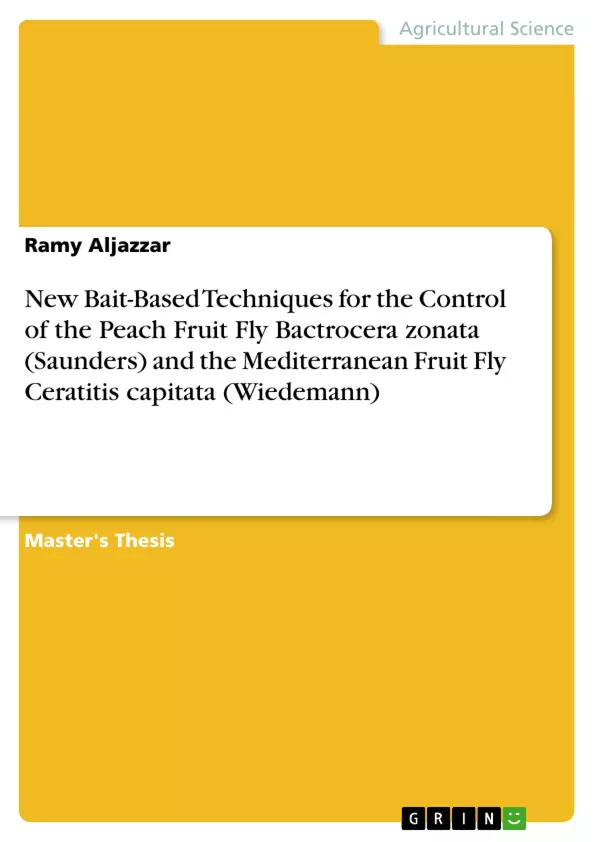Two bait-based techniques, Zonatrac Male Annihilation and Ceranock Attract and Kill, were used for the control of mixed populations of the Medfly Ceratitis capitata (Wiedemann) and peach fruit fly Bactrocera zonata (Saunders) on apricot and mango in Egypt. Treatments were carried out in an apricot orchard in Al-Beheira and later in a mango orchard in Al-Sharqiyah. Both techniques have proved to be successful in substantially reducing infestation on mango, where fruit damage assessment revealed infestation rates at 4.92% and 3.28% in two treatment plots, as opposed to 27.87% in an untreated control plot. The apricot trial witnessed a relatively high infestation rate in both treatment plots, as well as the control plot, due to an unexpectedly overwhelming Medfly population surpassing the application rate capacity. Apricot fruit damage assessment resulted in 51.92% and 42.72% infestation rates in the two treatment plots, and 44.55% infestation rate in the pesticide-treated control plot.
Inhaltsverzeichnis (Table of Contents)
- Chapter 1
- Introduction
- Chapter 2
- Literature Review
- General Information and Statistics
- Apricot
- Mango
- Use of Pheromones and Parapheromones in Pest Management
- Mediterranean Fruit Fly, Ceratitis capitata (Wiedemann)
- Taxonomic Hierarchy
- Morphology
- Biology
- Damage
- Integrated Management of C. capitata
- Peach Fruit Fly, Bactrocera zonata (Saunders)
- Taxonomic Hierarchy
- Morphology
- Biology
- Damage
- Integrated Management of B. zonata
- B. zonata in Egypt
- Background of the Study’s Control Strategies
- Control Strategies of the Study
- Principles of the A&K Technique
- Examples of A&K Systems
- Examples of Fruit Fly Attractants
- General Information and Statistics
- Chapter 3
- Materials & Methods
- Chapter 4
- Results & Discussion
- Apricot Trial
- Trap Catches
- Apricot Fruit Damage Assessment
- Mango Trial
- Trap Catches
- Mango Fruit Damage Assessment
- Statistical Analysis: “t”-test
- Apricot Trial
- Results & Discussion
Zielsetzung und Themenschwerpunkte (Objectives and Key Themes)
This research aims to evaluate the efficacy of two environmentally friendly control strategies, the Attract & Kill (A&K) technique and a bait-based Male Annihilation Technique (MAT), against mixed populations of the Mediterranean fruit fly (Ceratitis capitata) and the peach fruit fly (Bactrocera zonata) in apricot and mango orchards in Egypt. These techniques are tested as potential alternatives to conventional pesticide use, which has been linked to various harmful effects on human health and the environment.
- The study investigates the population dynamics of the PFF and Medfly in apricot and mango orchards in Egypt.
- It assesses the effectiveness of the Ceranock A&K technique against both fruit flies on apricot and mango.
- The research evaluates the effectiveness of the bait-based MAT Zonatrac against the PFF in both crops.
- The study highlights the potential of these techniques as eco-friendly alternatives to pesticide-based control measures.
- It analyzes the impact of these techniques on the balance of the fruit fly populations and the infestation rates in the treated orchards.
Zusammenfassung der Kapitel (Chapter Summaries)
Chapter 1 introduces the background of the study, focusing on the economic significance of apricot and mango production in Egypt, and the challenges posed by the Medfly and the PFF infestations. The chapter highlights the need for sustainable control measures due to the negative impacts of pesticide-based approaches on human health and the environment.
Chapter 2 provides a comprehensive review of relevant literature on the biology, behavior, and control strategies for the Medfly and the PFF. It discusses the principles of pheromone- and parapheromone-mediated control, including the A&K technique and the bait-based MAT, as well as the advantages and disadvantages of different commercially available products.
Chapter 3 details the materials and methods employed in the research. The chapter describes the two control techniques (Ceranock A&K and Zonatrac MAT), the monitoring traps used, data collection procedures, and the experimental design employed in the study. It also includes a detailed description of the two trial sites, one apricot orchard in Al-Beheira Governorate and one mango orchard in Al-Sharqiyah Governorate.
Chapter 4 presents the results and discussion of the experimental trials. It analyzes the trap catches for both the Medfly and the PFF, highlighting the seasonal population fluctuations and the effects of the applied treatments. The chapter further examines the fruit damage assessment in both crops, comparing the infestation rates in treatment plots and control plots, and drawing conclusions regarding the effectiveness of the two techniques.
Schlüsselwörter (Keywords)
The study focuses on the integrated pest management of two key fruit flies, the Mediterranean fruit fly (Ceratitis capitata) and the peach fruit fly (Bactrocera zonata), both of which pose significant challenges to fruit production in Egypt. The study critically evaluates the efficacy of two eco-friendly control strategies, the Attract & Kill (A&K) technique and a bait-based Male Annihilation Technique (MAT), as potential alternatives to conventional pesticide use. The research investigates the population dynamics of these fruit flies in apricot and mango orchards in Egypt, analyzing the impact of these techniques on infestation rates and the balance of the fruit fly populations in treated orchards.
- Literature Review
- Quote paper
- Ramy Aljazzar (Author), 2013, New Bait-Based Techniques for the Control of the Peach Fruit Fly Bactrocera zonata (Saunders) and the Mediterranean Fruit Fly Ceratitis capitata (Wiedemann), Munich, GRIN Verlag, https://www.grin.com/document/276134



